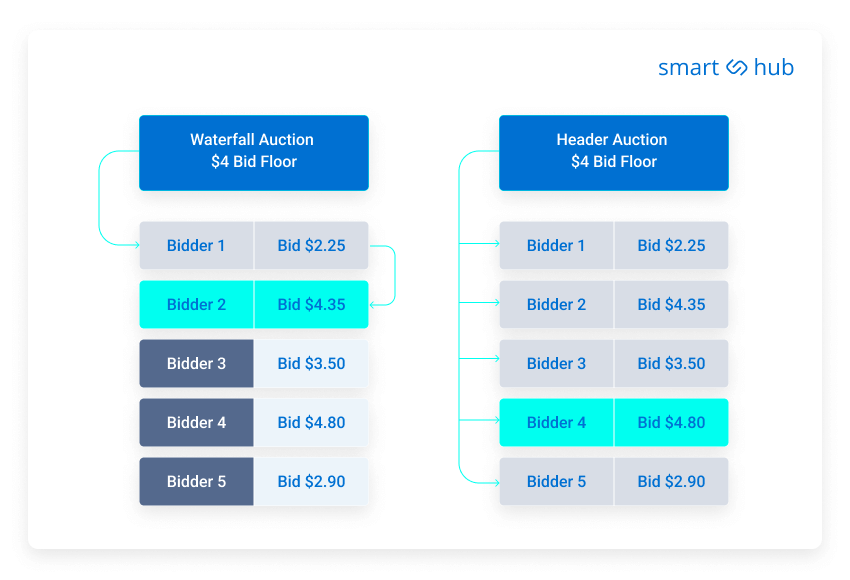Everything About Prebid Server Technology and How It Helps You to Connect Partners on SmartHub
 by Roman Vrublivskyi
by Roman Vrublivskyi
 by Roman Vrublivskyi
by Roman Vrublivskyi
The client-side and especially the server-side solutions of Prebid came to the ad tech scene with a big success since they enabled efficient header-bidding auctions. Prebid has introduced a revolutionary technology that enabled simultaneous bidding in unified actions that raised the efficiency of bidding tenfold. Today, when we march in the cookieless era, the Prebid server may even become a technology that keeps the adoption rate of the header-bidding intact in the future. As this technology doesn’t lose its relevance we decided to take it apart and see what’s in: how it works, what are the main benefits of it, and finally, how you can make use of it on SmartHub.
Prebid is a core technology thanks to which header-bidding auctions are getting enabled. Traditionally, the so-called “waterfall” model prevailed in programmatic but it wasn’t very efficient in terms of auction dynamics. The thing is, in the waterfall the bidding is happening in turns or one by one.
Let’s say there is a platform that sells advertising space. Its waterfall mechanism defines what buyers bid on impression first (ad networks, direct advertisers, etc). Normally direct buyers have a priority to access the inventory first. In case the impression doesn’t get bought in the first round, then the right to bid on it is transferred to the rest of the bidders. If the impression doesn’t get sold again, the rounds continue until the impression finds its buyer.
With such a hierarchy, buyers that can potentially offer much higher value for this impression sometimes do not get the chance to bid at all (since it is already sold to the higher-ranked participant for a smaller price). The higher the “waterfall” is, the more participants bid on the impression which also slows down the page loading. The header bidding, based on Prebid technology successfully resolved these problems. So, how does it work?
A special JavaScript code embedded in the header of the publisher’s web page enables header-bidding auctions, it is called client-side header bidding. When a user loads a web page, the code sends a request simultaneously to all partners connected to the publisher. Thus, the impression becomes available for everyone to bid on at the same time, which creates a favorable and fair media trading environment. The server-side header bidding is implemented on servers in order to remove the potential problems with latency on the publisher’s side.

Prebid was introduced in 2015, but to this day it is the most popular header-budding “container” or “wrapper” used by ad tech players around the world. When it comes to the mobile environment, the header bidding is getting enabled with open source SDKs which also helps to successfully alleviate the problem associated with possible latency in the apps.
Prebid server, in turn, brings a lot of benefits to the table:
In order to start with Prebid Server, publishers normally need to get the server first so that it could host the auctions (ad servers could be bought, rented, or obtained in partner relationships). Although Prebid Server significantly simplified the whole process, header bidding deployment may still take time – you may require the assistance of ad ops and additional time for signing up the contracts with bidders. Independent header-bidding implementation with Prebid Server might turn out to be costly for publishers and for this reason sometimes it makes sense to select solutions that already have all processes streamlined.
Earlier in the blog post, we introduced the function of Prebid Server technology in your system. With Prebid Server you can easily retrieve demand from ad exchanges through one server-to-server parallel bidding integration. This means that SmartHub will send requests to the Prebid Server of your demand partners (as if from publishers). The bidders, in turn, will send their bids back to the Prebid Server. The auctions will be running server-side and then after the auction winner is defined it will be transferred to the SmartHub.
With this, it’s worth noting that Prebid.org provides a full list of bidders and information about them such as media types supported, contact info, and their custom bid parameters. You can choose any bidder from the list and fill in its custom bid parameters on SmartHub. Read detailed info how to connect demand partners with Prebid server to server.
Additionally, with Prebid Server you can act as a DSP with its own bid adapter. We registered and added the SmartHub platform to the bid adapter list which enables the integration of partners on the supply side. While you add a new endpoint on the supply side 3 unique parameters will be generated and added to it. These parameters will be transferred to your partners so that trading could be initiated. Read the more detailed information on what kind of parameters will be passed in the request and how to get started server-to-server supply integration.
If you are thinking to start or boost your profitable programmatic business, choose SmartHub as a trusted partner. With SmartHub, you can confidently seize the prospects within the ad tech landscape, utilizing our robust platform to unlock exceptional outcomes. Experience the influence of a customer-centric approach, advanced technology, all encompassed customer support in the comprehensive white-label programmatic solution that provides SmartHub.
Explore the case studies of SmartHub to see how our clients earn on their white-label ad exchanges.
Prebid is a revolutionary technology that has reshaped the ad tech landscape and enabled header-bidding auctions. Prebid Server also made it possible to arrange auctions server-side so that the problem with latency was significantly eliminated. Indeed, Prebid Server is an open-source technology streamlined header-bidding deployment. In your system, Prebid Server enables you to easily retrieve demand and integrate supply partners for consistent boosting of your marketplace performance.
Want to Learn More?
Want to Learn More?
We'll get back to you very soon.